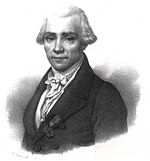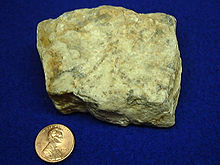Beryllium
Beryllium is a chemical element with the symbol Be and the atomic number 4. Its name can be derived from the mineral beryl, a gemstone containing beryllium (ancient Greek βήρυλλος bēryllos, German 'meergrüner Edelstein, Beryll', Latin beryllos 'sea-green Indian gemstone, beryl'). In this mineral, as well as in bertrandite, most of the beryllium present in the earth's crust is also bound. Beryllium belongs to the more rarely occurring metals.
It was discovered as a component of the mineral beryl as early as 1798 by Louis-Nicolas Vauquelin and initially called glucine because of the sweet taste of the isolated beryllium-containing compounds (e.g. the hydroxide). Elemental beryllium was first produced in 1828 by Friedrich Wöhler and independently by Antoine Bussy.
In the periodic table beryllium is in the second main group (2nd IUPAC group) and therefore belongs to the alkaline earth metals. As an element of the second period it belongs to the light alkaline earth metals. However, due to the relationship between charge and diameter of the divalent ion, it shows some unusual properties for this group, such as a higher density than its two homologues magnesium and calcium.
The steel-grey light metal is very hard and brittle, has a higher modulus of elasticity than steel and is mostly used as an alloying addition. In compounds it is divalent. Compared to the other light alkali and alkaline earth metals (lithium, sodium, potassium, magnesium and calcium) it is exceptionally toxic and harmful to health.
History
In antiquity and the Middle Ages, transparent beryl pieces were often used as visual aids, magnifying writing and images like a magnifying glass when reading.
The first recorded mention is in the 1st century Naturalis historia, where Pliny the Elder describes the similarity between the minerals beryl and emerald (beryl with a trace of chromium), but considers them to be different substances.
The Abbé R. J. Haüy found that beryl and emerald had the same physical properties in terms of hardness and density, as well as the same crystal form, and thereupon prompted the French chemist Louis-Nicolas Vauquelin to conduct an investigation.
Vauquelin proved in 1798 that beryl and emerald were chemically almost identical. He also isolated an oxide from both minerals, which he called terre du béril (beryl earth); it was similar to, but distinctly different from, the known aluminium compounds. Up to this time beryl had been considered, according to the previous analyses of T. Bergman,, F. C. Achard M. H. Klaproth, and L. N. Vauquelin for a calcium aluminosilicate. To the newly discovered substance the editors of Vauquelin's article gave the name Glucine, because of the sweet taste of the beryllium salt (Greek γλυκύς glykys 'sweet'). Names such as glucinum, glucinium or glycinium were still used in France and some other countries until the 20th century, although already M. H. Klaproth and A. G. Ekeberg pointed out in 1802 that sweet taste is by no means a special property of the salts of beryllium, salts of yttrium also taste sweet, and therefore the name beryllium earth was preferable.
The first reports of attempts to prepare the element were published by H. Davy in 1809 and by F. Stromeyer in 1812. However, it was not until 1828 that Friedrich Wöhler and, shortly afterwards, Antoine Bussy succeeded in preparing the element by reducing beryllium chloride with potassium. Wöhler named the new element beryllium. The element discovered in 1836 in davidsonite (a variety of beryl), named donium by T. Richardson and treenium by H. S. Boase, turned out to be beryllium. M. Avdeev made the first determinations of exact atomic weight in 1842. Julius Weeren (1854) and Henry Debray (1855) also made extensive investigations of the metal, its elemental properties, and its compounds. Charles Arad Joy (1863) also explored the preparation of beryl compounds. It probably became known to wider circles at the Paris World's Fair in 1867, where a larger quantity was exhibited for the first time.
The chemical symbol Be was introduced in 1814 by J. J. Berzelius.
Great advances in the chemistry of beryllium were made between 1873 and 1885 by Albert Atterberg, L. F. Nilson and O. Pettersson. During these years, the valence of beryllium and its position in the periodic table were also intensively discussed. Numerous other researchers later also contributed to the development of the chemistry of beryllium.
Pure beryllium in crystalline form was first produced in 1899 by Paul Marie Alfred Lebeau by fused-salt electrolysis of sodium tetrafluoridoberyllate (Na2[BeF4]). After World War I, beryllium was produced simultaneously by Siemens & Halske AG (Alfred Stock and Hans Goldschmidt) in Germany and by Union Carbide and Carbon Corporation (Hugh S. Cooper) in the United States. After World War II, the Beryllium Corp. of America in Cleveland was the main producer of high-purity beryllium in America, and the National Physical Laboratory in England researched the element.
In 1945, beryllium was used together with the alpha emitter polonium as a neutron source in the atomic bomb Little Boy, which was dropped on Hiroshima.
Until the 1940s, beryllium compounds were used as an ingredient in fluorescent tubes (for example, zinc-manganese-beryllium silicates), but this ended as more and more cases of berylliosis were uncovered. Berylliosis was also first described in 1946 based on workers in this industry.

Louis-Nicolas Vauquelin (1763-1829)
Manufacture
The most important starting material for the preparation of beryllium salts as a starting material for the production of beryllium is beryl, which usually contains iron in addition to the aluminum content given by the formula. In addition to the actual digestion, the separation of the beryllium from the aluminum and iron is therefore important. The decomposition is carried out either by means of alkaline fluxes
or by means of fluorides or silicofluorides.
In addition to beryl, gadolinite and leucophane are also used as starting materials for beryllium salts with decomposition by sulphuric acid or aqua regia, for example.
The resulting beryllium hydroxide is reacted with ammonium bifluoride to form ammonium fluoroberyllate, which in turn decomposes at elevated temperatures (> 125 °C) to form beryllium fluoride and volatile ammonium fluoride. To produce beryllium chloride, beryllium hydroxide is converted by heating to beryllium oxide, which reacts with carbon and chlorine at 800 °C to form the desired anhydrous beryllium chloride.
Elemental beryllium is produced by reduction of beryllium fluoride with magnesium at 1300 °C. The reaction starts at low temperatures, but above 850 °C the reaction rate increases after both magnesium and beryllium fluorides have melted.
High purity metallic beryllium is produced by fused-salt electrolysis of beryllium chloride with lithium chloride at 500 °C or sodium chloride at 350 °C or beryllium fluoride with lithium fluoride or potassium fluoride at 500 °C:
Beryllium is deposited at the cathode in the form of a fine beryllium powder, which is lifted out of the melt from time to time with the cathode, scraped off and - after removal of adhering salt (washing with water) - transformed into compact pieces by sintering at 1150 °C. The beryllium powder is then removed from the molten metal.
The world annual production of beryllium metal in 2018 was about 230 t. Proven global reserves to date amount to over 100,000 t. The price of beryllium as a fully processed aerospace component ranges from €300 to €1500/kg. As a commercial product in the form of wires or foils of pure beryllium (> 99.5 % beryllium content) also significantly more expensive (> 10,000 €/g.).

Beryllium ore
Search within the encyclopedia
![{\displaystyle {\ce {Al2Be3[Si6O18] + 6 H2SO4 -> 3 BeSO4 + Al2Si6O12(SO4)3 + 6 H2O}}}](https://www.alegsaonline.com/image/33e8fe20d31b54d4526f931c5a6454f1b357d510.svg)

![{\displaystyle {\ce {Al2Be3[Si6O18] + 6 Na2SiF6 -> 3 Na2BeF4 + 2 Na3AlF6 + 9 SiO2 + 3 SiF4}}}](https://www.alegsaonline.com/image/f93130c018cdc4c1daf0013d9a4a245ccca49b0f.svg)



